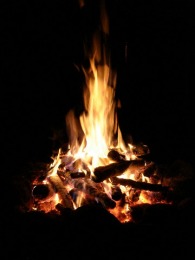 Charcoal is a major ingredient in the super-fertile, man-made, Amazonian soil called Terra Preta. Terra Preta is being intensively studied as a hopeful solution for the impending agricultural and climate crisis. People have now been experimenting with a lot of complicated methods for making charcoal for Terra Preta, in as clean and efficient a manner as possible, involving double chambered barrels, and tubes and chimneys, and such. The quest is to make charcoal with as few greenhouse emissions as possible, while utilizing the heat generated from the fire for something useful. I've become involved with experimenting with some of these methods on a home-scale, and I will let you know how it goes in future articles. In the meantime, I came across a very simple way of making some charcoal, in a substantial enough volume for your garden beds, in a video on YouTube by Greenpower,. 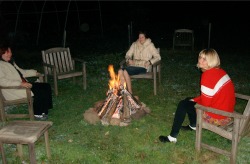 It involves simply burning some dry deadfall branches in your backyard, and then dousing the fire suddenly and thoroughly with water, at the point when you have a nice bed of red coals. "It can't be that simple," I thought. "The charcoal must not be as good that way." But when I compare the finished result of the charcoal from the doused coals, with my purest pyrolized charcoal from an oxygen sealed container, I see absolutely no difference in the structure of the charcoal. ( I will admit that it doesn't smell as good, though. The charcoal from the fire pit smells a little sooty, while the pyrolized charcoal smells ultra-clean.) When you douse the hot coals with plenty of water, there isn't much ash left behind, and what there is, has had the caustic soda washed out of it, so it won't burn your plants. With dry wood, the fire burns pretty cleanly, though the heat from the fire is mostly wasted, of course. The fire was very enjoyable for us though, as we warmly sat around it and relaxed on a cold evening, and chatted. You get to enjoy the bonfire, while turning dead-fall branches into carbon that will be sequestered in your garden for perhaps 5000 years or more. 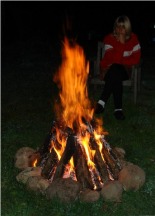 To produce the most amount of charcoal, and the least amount of ash, you can plan the structure of the fire ahead of time. Have your firewood sorted by diameter, and cut to size. Use just enough kindling at the beginning to get your largest logs burning. This kindling will be all that really has a chance to burn down completely into ashes. The rest of the firewood can then be added sequentially, with timing to produce the maximum amount of red coals simultaneously. Once the largest logs are burning, you can then gradually add smaller and smaller pieces of dry wood to the fire, as the larger pieces are turning to red coals. You time it to turn the maximum amount of wood into red coals, ready for dousing at the same time. This adds to the aesthetic enjoyment of the fire, because you maintain it at a high blaze for a prolonged amount of time. You can create the maximum amount of coals per fire this way, while producing the least amount of ash, and with the most clean-burning, hot, and efficient blaze possible. Traditional, oxygen deprived methods of making charcoal in pits, are supposed to be the worst in terms of air pollution. 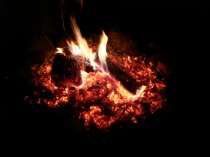 If your timing isn't perfect, or the wood is too wet, or varied in size, and you have a few larger pieces that are still burning at the time when you already have a substantial amount of coals, douse the fire anyway. If you wait for the larger pieces to burn down, the smaller coals will burn down to ashes. So to get the most amount of charcoal, put the fire out at the point where you have the most amount of coals. The larger chunks of unburned wood can be added to your next fire. 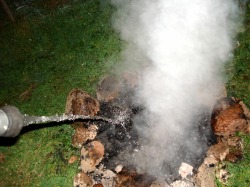 To douse the fire, use a lot of water, and put the fire out quickly, and thoroughly. You want to make sure that everything completely stops burning instantly, so that it doesn't keep smoldering and producing carbon monoxide, nor keep burning the coals at the bottom into ashes. Lots of water will also wash the ashes away from the charcoal, and leach the caustic soda out of what ashes are left. The finished result is a clean charcoal with a porous structure, that creates an ideal habitat for soil micro-organisms. 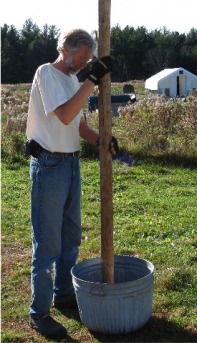 To use your charcoal, or "bio-char", in your garden, you must first grind it up and mix it 50/50 with compost. To grind it up, I simply scoop up the charcoal with a flat shovel from the fire-pit, and dump it into a galvanized bushel basket, until I have about a 4-5 inch layer in the bottom. Then I chop the charcoal with the shovel into smaller bits. Next, I pulverize the charcoal, by pounding it with a wooden fence-post. This quickly crushes the charcoal into a coarse powder. The nice thing about working with the moist bio-char from the doused fire, is that it doesn't make any dust when you pound it. When you try to grind up charcoal that was properly pyrolized (in an oxygen-less chamber of some sort), it is extremely dry and dusty. If you wish to add the powdered charcoal to your garden right away, first add an equal volume of finished compost to the bin, and mix it up. You can mix in additional amendments, like kelp or Azomite, at this time as well. Then spread the mixture on your garden beds, and till it in. I use a broadfork, followed by a 3-tine cultivator for this. Since it takes time for micro-organisms to take up residence in the bio-char, and the bio-char sucks up some of the nutrients from the soil at first, a better way might be to add the bio-char to your working compost pile, and give it more time to age, before adding it to the soil. I think my favorite thing about adding bio-char to my garden soil, is that unlike just about everything else that has to be done over and over again on a farm, once you've added bio-char to your soil, it's done! It will stay put for hundreds, maybe even thousands of years. You can keep adding more, but you never lose ground. The benefits just increase. - Botan Anderson For further info on bio-char and terra preta, try these links: http://en.wikipedia.org/wiki/Terra_preta http://www.biocharsolution.com/ http://www.airterra.ca/biochar-what-is-biochar/ http://terrapreta.bioenergylists.org/Making_BioChar http://news.nationalgeographic.com/news/2008/11/081119-lost-cities-amazon.html http://newenglandbiochar.org/Home.html http://www.truehealth.org/terrapretainterview.html http://www.truehealth.org/terrapreta-farming.html http://www.biochar-international.org/ Comment: Hi, I have come to the same conclusions as you have in simple, open-fire charcoal making. (Although I rapidly build UP the fire to the largest diameter in an "inferno" setting, then work back down slowly to kindling) It's super-efficient, and I'm glad to see others building knowledge on their own, based on the properties of materials. It's so much better than metal boxes that still make ash (they don't count the stuff outside the metal box, lol) Check out my Terra Preta video, on the properties of materials, charcoal.
1 Comment
new_biochar_land
1/31/2011 11:16:30 pm
You want to know all the secrets about biochar ?
Reply
Your comment will be posted after it is approved.
Leave a Reply. |
Botan AndersonArchives
March 2023
Categories
All
|
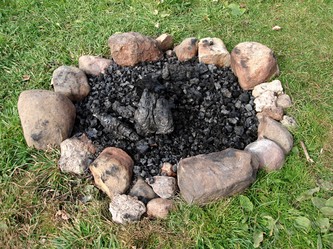
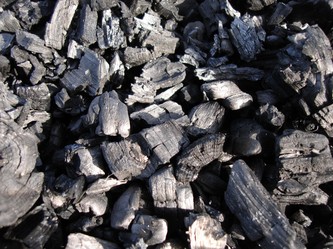
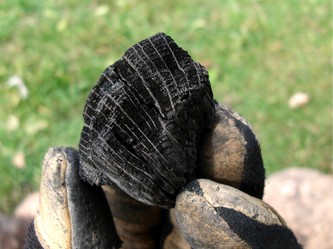
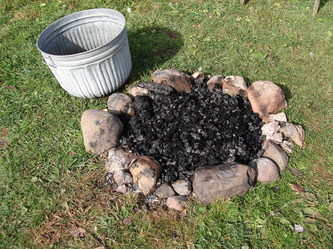
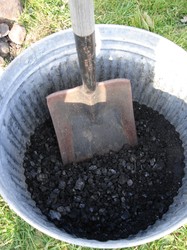
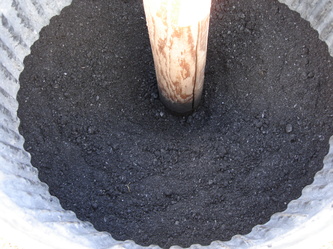
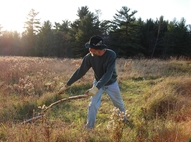
 RSS Feed
RSS Feed